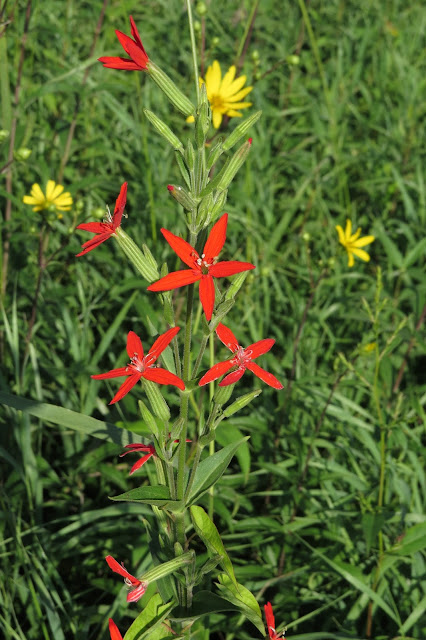As a result, there are just a few small pockets of original prairie remaining, and some have been designated as state nature preserves. These are remnant parcels that, for whatever reason, were not suitable for agriculture such as cemeteries and railroad rights of way. Interestingly, over the past two decades or so, many park managers and even private property owners have reverted former farm fields by planting seeds of prairie plants.
Thanks to all the rainfall the past few weeks, these areas are bursting with blooms and are well worth a visit over the next few weeks. This weekend we visited a couple of original prairie remnants and the developing prairies at Battelle Darby Metro Park. All are absolutely spectacular!
Here is a look at Bigelow Pioneer Cemetery State Nature Preserve, west of Plain City in central Ohio. This half-acre parcel has never been plowed or grazed, which is quite remarkable here in Ohio. The earliest known burial dates from 1814, and the latest is 1892. Surrounded on three sides by soybean fields, it still supports a nice variety of wildflowers typical of the Darby Plains.
Purple coneflower is familiar to a lot of people as a garden plant but it's also a characteristic plant of the tallgrass prairies. It is a valuable nectar source for a variety of insects and does indeed make a great addition to landscaped areas.
Gray-headed coneflower is coming into bloom now and is one of the taller plants currently in bloom:
This robust plant is prairie dock, with its huge sand papery leaves and tall flower stalk. It can get up to 10 feet in height and is one of the most obvious indicators of prairie habitat.
This brilliant red-flowered plant is royal catchfly, so named because the flower's calyx is quite sticky. A ruby-throated hummingbird was checking out the blossoms as we walked around the path on Saturday.
Here is a rare salmon-colored variant of the royal catchfly:
Here is a rare salmon-colored variant of the royal catchfly:
A favorite moth nectar plant is prairie monarda, which also goes by the names of beebalm and bergamot.
These are a few of the more dominant plants blooming at the cemetery right now but soon the goldenrods and ashy sunflowers will sport their brilliant yellow blooms.
Not far from Bigelow Cemetery is Smith Cemetery State Nature Preserve. They share many of the same plant species, and Smith is definitely worth a visit:
Friday night we took a picnic to Battelle Darby Creek Metro Park where park managers and volunteers have converted over 500 acres of formerly agriculture land into prairie. Using seeds collected from Darby Plains plants, they are recreating the habitat that Ohio pioneers removed to get to the dark fertile soils beneath. Here are two views of the restored prairie--picture hundreds of acres that are equally spectacular:
Any of these areas are well worth a visit over the next few weeks. As summer fades into fall, flocks of goldfinches will be eagerly feeding on the seeds of these prairie plants; that can be as interesting a spectacle as the blooming plants!











Wow! These prairies are gorgeous. I remember the first summer we moved to Wisconsin and I took a book out of the library to learn more about prairie plants. It was so interesting to find out about how they adapted to these conditions, including their deep roots. Did you have time to look at the gravestones, also? I can imagine they are quite interesting. As always, thanks for sharing your beautiful photos and for educating us on what you've seen.
ReplyDeleteThanks! There are some wonderful gravestones in those cemeteries, some with lovely designs. Many reflect the sadness of death in childbirth and death of very young children, although some people lived into their 80s and 90s! Right now many are engulfed by the lush growth around them but some are still readable. The granite ones are in the best condition by far!
ReplyDelete